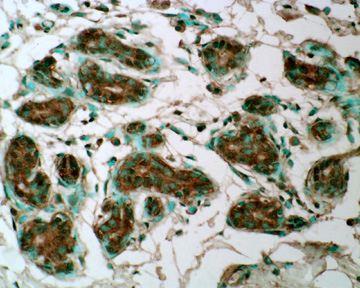Anti-GPX7 Antibody (13911)
Anti-GPX7 Antibody (13911)
Product No.: 13911
- -
- -
Clone 2704 Target GPX7 Formats AvailableView All Product Type Monoclonal Alternate Names GPx-7, GSHPx-7, EC 1.11.1.9, CL683 Isotype Mouse IgG2a Applications IHC , IHC FFPE , WB |
Data
![Non-transfected (–) and transfected (+) 293T whole cell extracts (30 ug) were separated by 12% SDS-PAGE, and the membrane was blotted with GPX7 antibody [2704] (13911) diluted at 1:500 The HRP-conjugated anti-mouse IgG antibody was used to detect the primary antibody.](https://www.leinco.com/wp-content/uploads/2025/01/qed-bioscience-anti-gpx7-antibody-13911-3.jpg) Non-transfected (–) and transfected (+) 293T whole cell extracts (30 ug) were separated by 12% SDS-PAGE, and the membrane was blotted with GPX7 antibody [2704] (13911) diluted at 1:500 The HRP-conjugated anti-mouse IgG antibody was used to detect the primary antibody.
Non-transfected (–) and transfected (+) 293T whole cell extracts (30 ug) were separated by 12% SDS-PAGE, and the membrane was blotted with GPX7 antibody [2704] (13911) diluted at 1:500 The HRP-conjugated anti-mouse IgG antibody was used to detect the primary antibody. - -
- -
Antibody DetailsProduct DetailsReactive Species Human Host Species Mouse Immunogen Full length human GPX7 Product Concentration Lot Specific Formulation PBS, pH 7.2. State of Matter Liquid Product Preparation Purified by Protein G affinity chromatography Storage and Handling This product is stable for at least one (1) year if stored at -20°C. Store product in appropriate aliquots to avoid multiple freeze-thaw cycles. Regulatory Status Research Use Only Country of Origin USA Shipping Next Day 2-8°C Applications and Recommended Usage? Quality Tested by Leinco Immunoblotting: use at a 1:500-1:2,000 dilution. A band of ~18kDa is detected. Detection of GPX7 in HeLa cell extract. Each investigator should determine their own optimal working dilution for specific applications. See directions on lot specific datasheets, as information may periodically change. DescriptionDescriptionSpecificity This antibody recognizes human GPX7. Background Glutathione peroxidases (GPXs) are some of the most important enzymes involved in removing
reactive oxygen species (ROS). GPX7 (along with GPX5 and GPX8) is a non-selenocysteine
glutathione peroxidase. When cells are exposed to oxidative stress, GPX7 acts as an
intracellular sensor that detects redox level and transmits ROS signals to redox-sensitive, thiolcontaining proteins to facilitate the regulation of multiple biologic processes such as protein
folding and releasing non-targeting short interfering RNAs (siRNAs)-associated stress. Function It protects esophageal epithelia from hydrogen peroxide-induced oxidative stress. It suppresses acidic bile acid-induced reactive oxigen species (ROS) and protects against oxidative DNA damage and double-strand breaks. {PubMed:22157330}. NCBI Gene Bank ID UniProt.org Research Area Enzymes References & CitationsTechnical ProtocolsCertificate of Analysis |


![Detection of GPX7 using GPX7 antibody [2704] (13911) in HeLa whole cell extract.](https://www.leinco.com/wp-content/uploads/2025/01/qed-bioscience-anti-gpx7-antibody-13911-1.jpg)

![Various whole cell extracts (30 ug) were separated by 15% SDS-PAGE, and the membrane was blotted with GPX7 antibody [2704] (13911) diluted at 1:1000. The HRP-conjugated anti-mouse IgG antibody was used to detect the primary antibody, and the signal was developed with Trident ECL plus-Enhanced.](https://www.leinco.com/wp-content/uploads/2025/01/qed-bioscience-anti-gpx7-antibody-13911-4.jpg)
![GPX7 antibody [2704] detects GPX7 protein at cytoplasm by immunohistochemical analysis. Sample: Paraffin-embedded mouse stomach. GPX7 stained by GPX7 antibody [2704] (13911) diluted at 1:100. Antigen Retrieval: Citrate buffer, pH 6.0, 15 min](https://www.leinco.com/wp-content/uploads/2025/01/qed-bioscience-anti-gpx7-antibody-13911-5.jpg)
